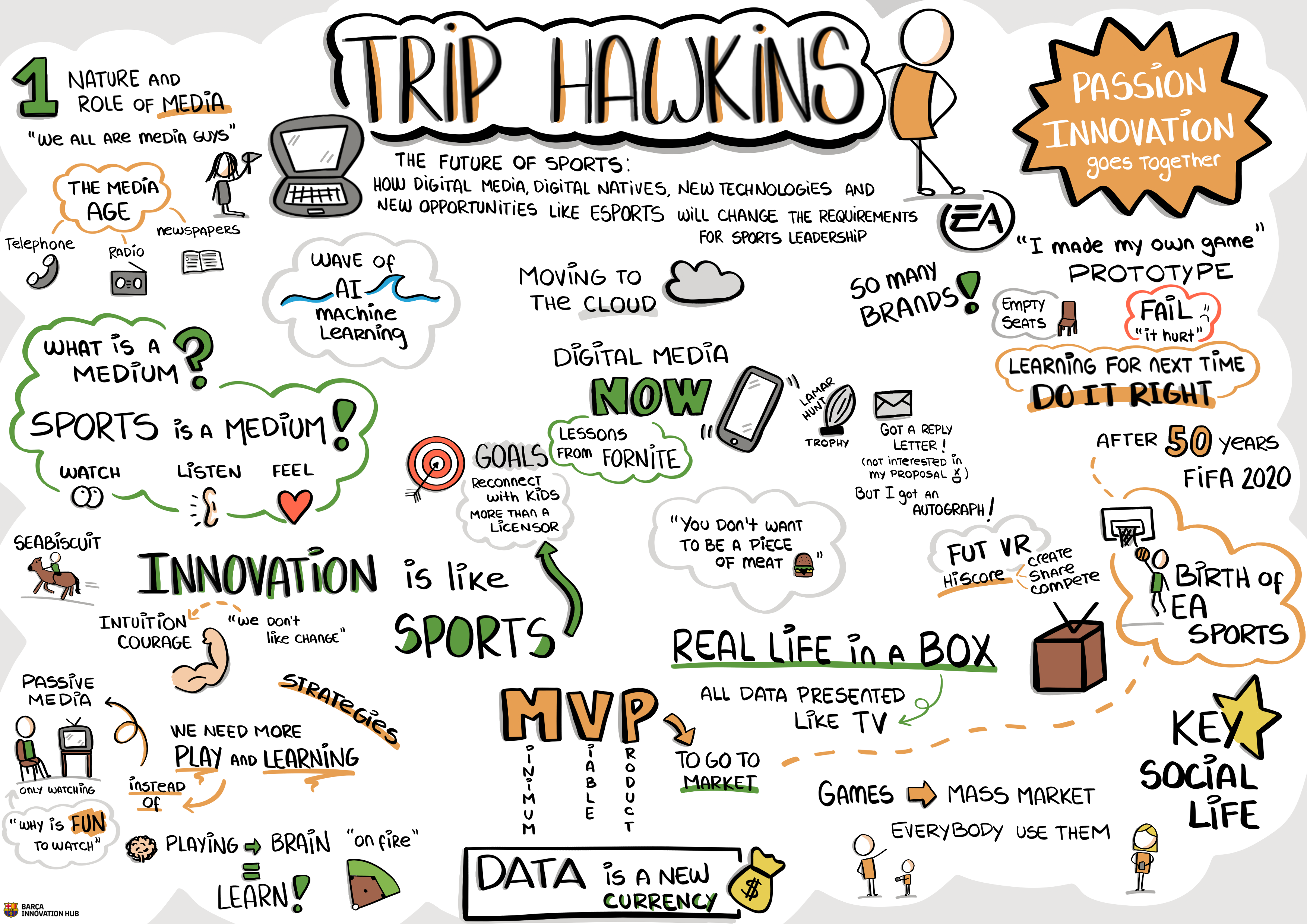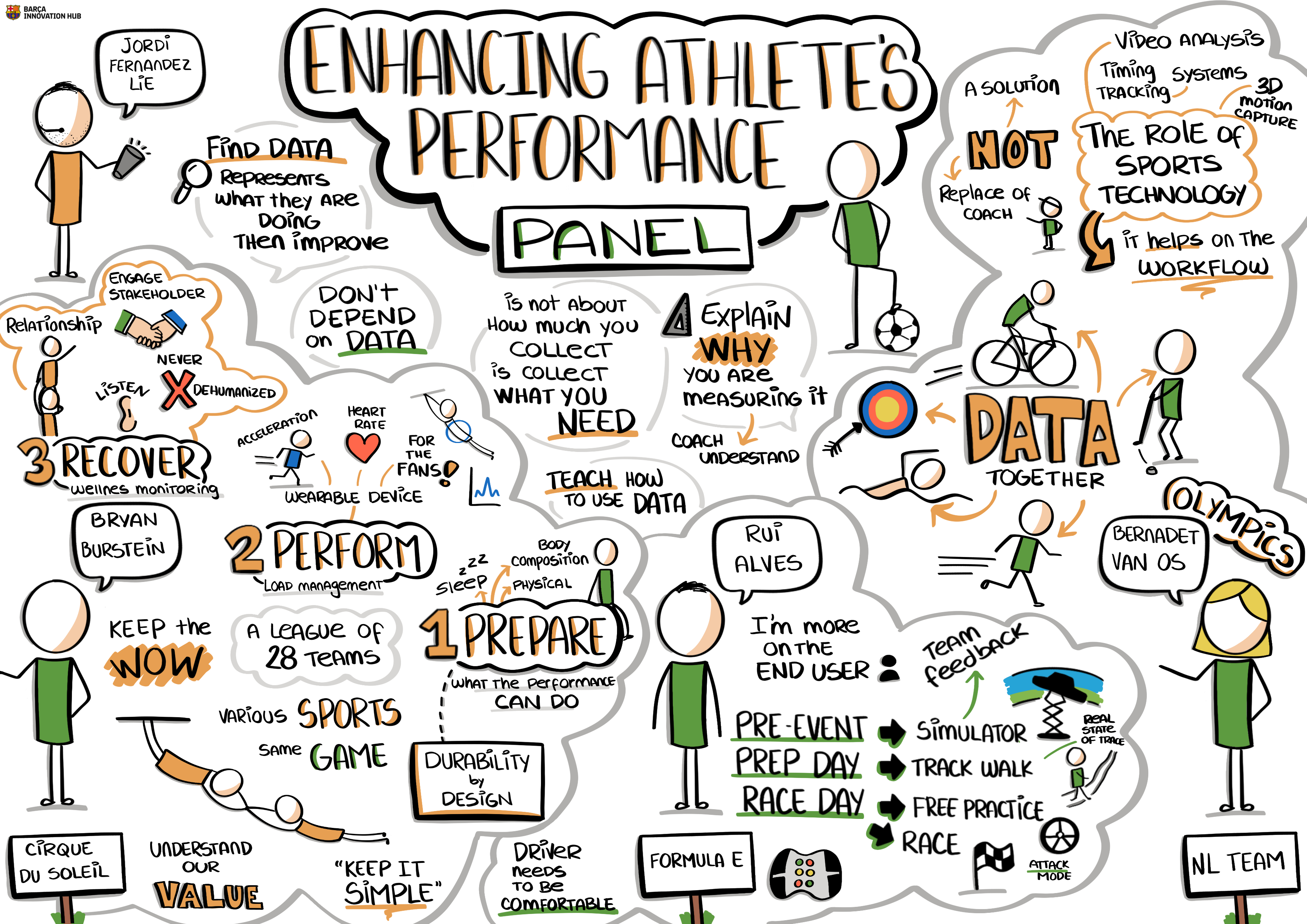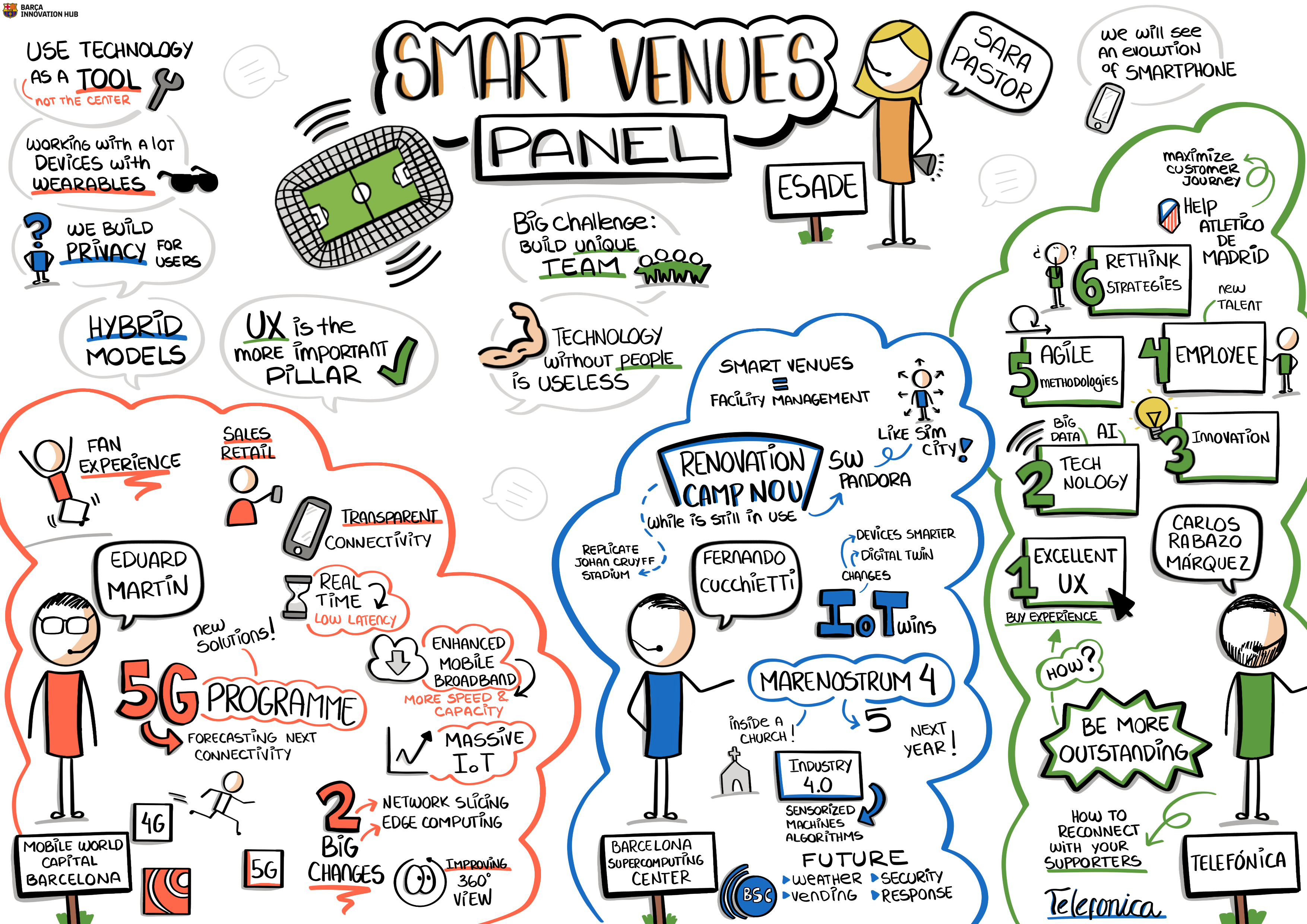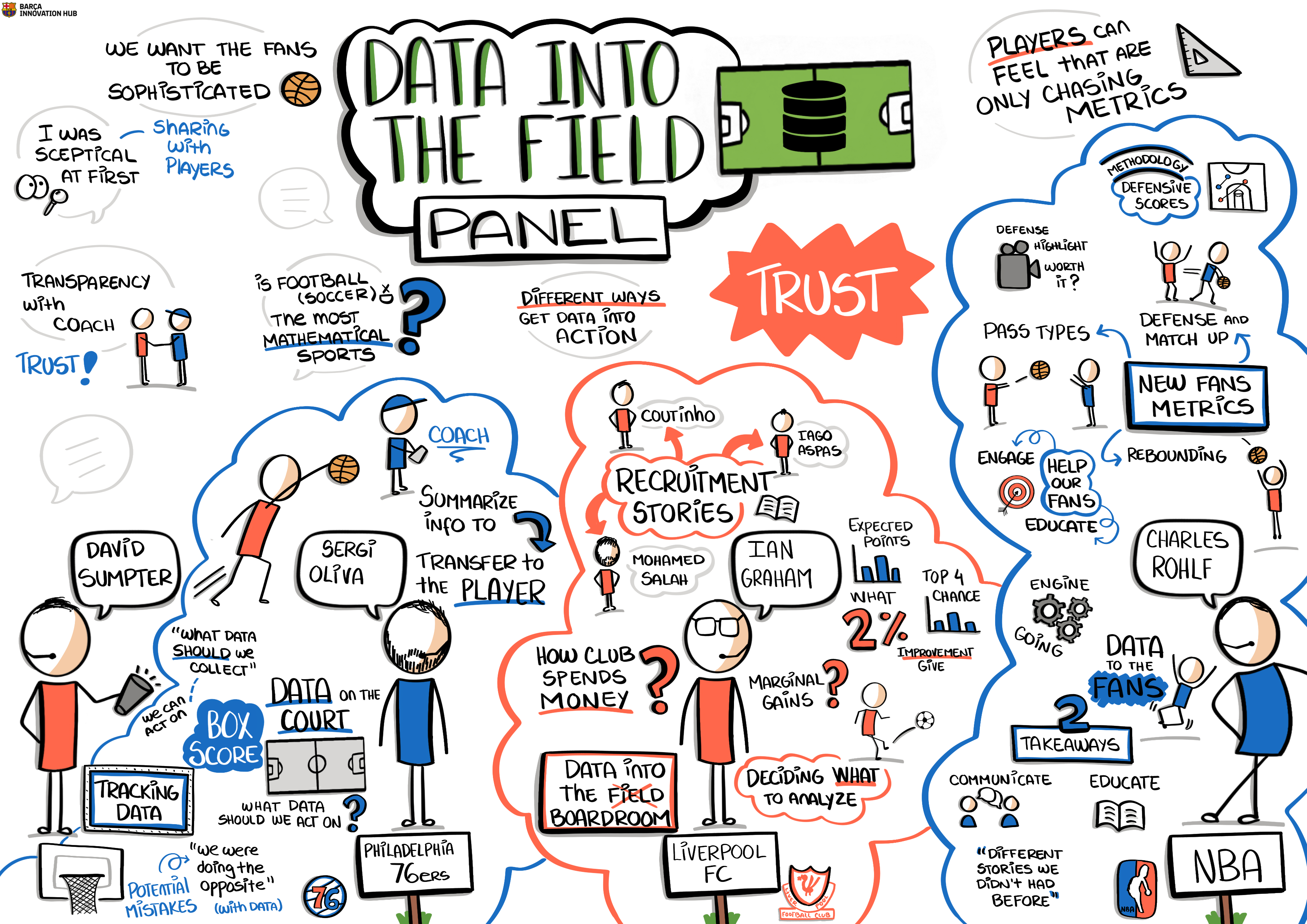During the next three years, the sports world will change more than it has done in the last ten. This is one of the conclusions expressed at the Barça Sports Technology Symposium, a meeting where experts discuss the technological forefronts in the world of sports.
On the first day, Trip Hawkins, founder of EA Sports, revealed how his interest in technology started when he was a kid, being a baseball fan. Early on, he tried to transfer sport emotions into simulators but back then he could only do it on board games. He didn’t succeed but he found his true vocation. Nowadays, kids with computers are just one step from designing games like Fortnite or Pokemon Go.
Even though EA Sports specializes in great realism videogames, he recognized that fun, creative and less dramatic games are the most successful ones. At the same time, the rise of videogames is emptying the assistance of young sports fans to stadiums as the new young spectators attend videogame competitions. The best players are already starting to earn salaries similar to those of elite athletes, he warned. His advice is that sports should adapt and not turn its back to this new reality. Following this idea, he anticipated that in 20 years from now, Fortnite will be a “serious” sport and for that reason, we should find and explore a new common ground to bond both worlds.

A glimpse into the future
Aaron Frank, from the Singularity University, opened the Future world and its impact on sports panel. He explained that technology development is experiencing exponential growth and soon 3D printing and virtual reality will be accessible everywhere. Web pages will have a virtual space and our avatars will be as important as the clothes we are wearing. He mentioned that virtual reality shopping is more developed in China than in the United States.
Flagship Pioneering encompasses a new breed of specialized and innovative companies which focus on the nutrition industry. John P. Casey explained that they cover the whole food chain process. From the crops and its processing respecting the environment to food design that is analyzed at a molecular level to reduce possible adverse health effects. One of its main challenges is to avoid salts and sugar but still create appetizing food.
Tucker Kain, from Los Angeles Dodgers, showed how the most ungrateful tasks in the kitchen at the new club’s stadium will be done by mechanical arms and robots. They are also working on new stadium accesses such as an underground railway or gondolas to avoid traffic within the city.

Continuous improvement of athletes
The Enhancing Athlete performance panel was opened by Bryan Burnstein from Cirque du Solei. He explained how they’ve been able to apply sports athlete tracking to their artists, where performance is even more demanding in some cases. On the contrary to professional sport, they have more show appearances than training sessions, around 476 acts per year. This technology advance has enabled to stop the physical deterioration of their performers which allows them to prolong their careers. Also, they are now able to personalize rehearsal instructions and use the analyzed data to prove that one more hour of quality sleep per week, has been useful to improve performance by 90%.
The E Formula is a race created by FIA. It uses electric single-seating formula cars which serve as a research laboratory for the development of vehicles that work with this kind of technology. Rui Alves, from the Audi Sport Team, mentioned that in this competition, vehicles run with limited energy and therefor strategies have to be established to make the most out of it. To train, last generation simulators are used to identify each field pothole and irregularity alongside scouts that previously walk around the racing course.
Bernadet van Os, from the Dutch Olympic team, exposed the different technologies they have incorporated since the last Olympic Games for all sport disciplines, from BMX to swimming. The main function they have optimized is enhancing coaches, whose athletes’ performance has received better feedback thanks to the use of tracking devices and video. The smart suit, which measures vital variables in real-time, was employed for speed skating. Lastly, Van Os recommended that scientists and innovators should work with the teams in-depth on the field to gain further insights to develop existing technologies.

Smart decisions
During the Data-driven decision-making panel, Víctor Oliver, the facilities business director at FC Barcelona, acknowledged the difficulties the club has to sell the few available tickets from club members that don’t attend or invitations. With the Smart Booking project, they use the Seient Lliure service, which allows members who will not attend, free their seat. Through data analysis, the club can predict when they’ll leave their seats free to sell them as tickets in advance. This has increased sales by 15%.
José Carlos Franco, from La Liga, presented the new entity’s platform where different sport competitions will be aired. Thanks to data analysis, they have developed a customer profile optimization strategy to offer them their favourite content linked to different proposals which are of their interest.
Mauricio Bonomi has a broad experience in banking and other companies. In his presentation, he stated that communication between departments is one of the biggest problems in the majority of the companies he’s worked for. Now at AC Milan, he is implementing a centralized data management system which connects all the club’s departments, from scouts that bring in new players, to the medical and marketing department. They all work with the same database as a hub.

Smart Venues
Eduard Martín, from the Mobile World Capital Barcelona, introduced Smart venues and how the 5G revolution will affect the sports world. Data influx will be much greater, the current demand grows around 67% annually. Also, interconnectivity among fans will completely change the experience of attending a game. Martin also added that hands-free will be the next revolution by removing devices to create a more comfortable and natural experience.
The problem of entering or leaving a stadium, especially when the stadium is under construction as it will happen next year at Camp Nou, can be solved with a supercomputer. Fernando Cucchietti, from the Barcelona Supercomputing Center, explained how they’ll implement it for Barça. The system foresees and simulates individual movements done by hundreds of thousands of people. This will allow helping to establish the correct flow within the stadium to make it easy for attendees to get in and out quickly. It could also establish real-time evacuation plans and detect possible emergencies.
In the case of Atlético de Madrid’s new stadium, the Wanda Metropolitano. Carlos Rabazo revealed that its new business systems’ objectives are to offer a complete experience for people attending the venue. In this case, the Smart Stadium project can profile different types of fans such as tourists and loyal fans who go to all the games. This, in turn, helps the shops inside to offer the appropriate products for them and hence increase consumption inside the stadium.

Data quality
The last panel of the day was Data on the field, where football and basketball experts are sceptical regarding the rise of data analytics. Sergi Oliva, from the Philadelphia 76ers, talked about the need to distinguish between gathering large amounts of data and selecting a set of data that can really contribute to something important. He said that, for years, data in the NBA has been analyzed according to the criteria of people who started to gather it in the 50s. This information marked the way to understand the game and evaluate players but it didn’t reflect what was really happening on the court, leading to many mistakes until tracking appeared 6 or 7 years ago, bringing a new vision on what sort of data needs to be compiled. As an example, he explained how gathering data of a players efficacy when scoring, can differ if there are one or two players defending. These percentages could help a coach on deciding a strategy, he commented.
Charlie Rohlf, NBA Sr Director – Stats Technology Product Development, considered that data analysis must always be done having in mind an educational facet. A spectator or fan will show more interest if he or she discovers new insights through the information they receive. For this to take place, a data expert is needed to interpret the numbers in order to showcase explanatory information. According to him, the statistical information that basketball needs has to show the type of passes from each player alongside the defence and the number of pairings.
Finally, Ian Graham from Liverpool FC manifested that statistics are still very tricky. The same data can highlight a player’s profile when in reality that player doesn’t have the quality expected and vice versa. There’s still a long way to go for data to be a decisive tool for a club to use when investing to acquire a new player or for coaches to take key decisions during a match. He concluded by saying that to interpret big data more than a simplified reading of the figures is needed because these show a complex reality. He also alerted that if excessive importance is given to data, there’s a risk that this obsession will also lead to players becoming obsessed and modifying their game just to get better numbers.

The Barça Innovation Hub team
KNOW MORE
CATEGORY: MARKETING, COMMUNICATION AND MANAGEMENT
This model looks to the future with the requirements and demands of a new era of stadiums, directed toward improving and fulfilling the experiences of fans and spectators, remembering “feeling” and “passion” when designing their business model.
CATEGORY: FOOTBALL SPORTS PERFORMANCE
Through the use of computer vision we can identify some shortcomings in the body orientation of players in different game situations.
CATEGORY: MEDICINE HEALTH AND WELLNESS
A health check must detect situations which, despite not showing obvious symptoms, may endanger athletes subject to the highest demands.
CATEGORY: FOOTBALL TEAM SPORTS
In the words of Johan Cruyff, “Players, in reality, have the ball for 3 minutes, on average. So, the most important thing is: what do you do during those 87 minutes when you do not have the ball? That is what determines whether you’re a good player or not.”
CATEGORY: MEDICINE HEALTH AND WELLNESS SPORTS PERFORMANCE
Muscle injuries account for more than 30% of all injuries in sports like soccer. Their significance is therefore enormous in terms of training sessions and lost game time.
DO YOU WANT TO KNOW MORE?
- SUBSCRIBE
- CONTACT
- APPLY
KEEP UP TO DATE WITH OUR NEWS
Do you have any questions about Barça Universitas?
- Startup
- Research Center
- Corporate